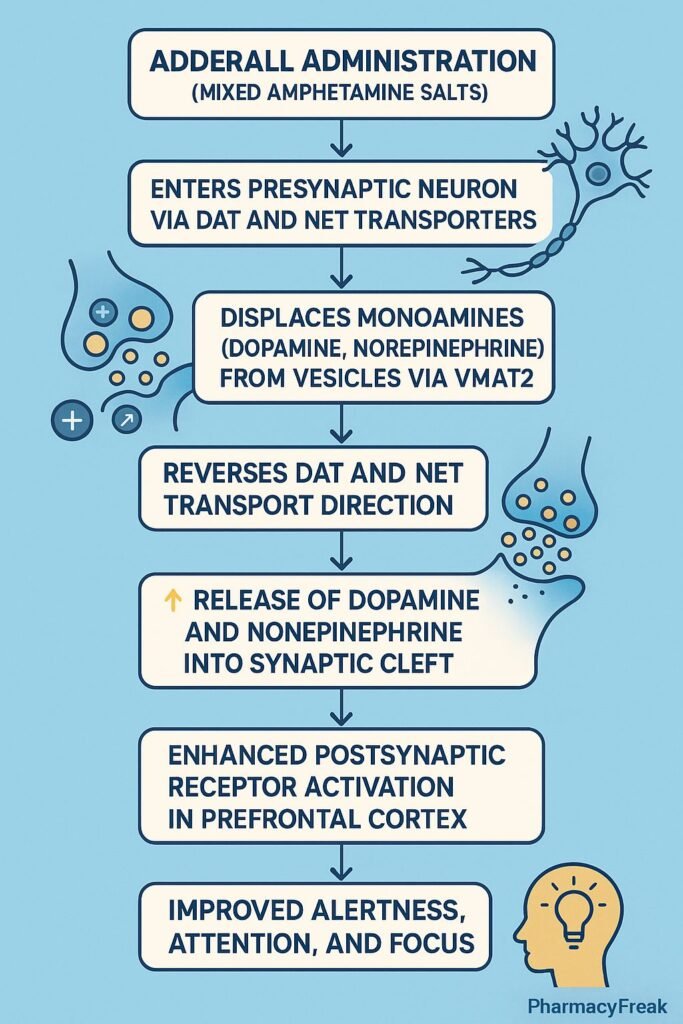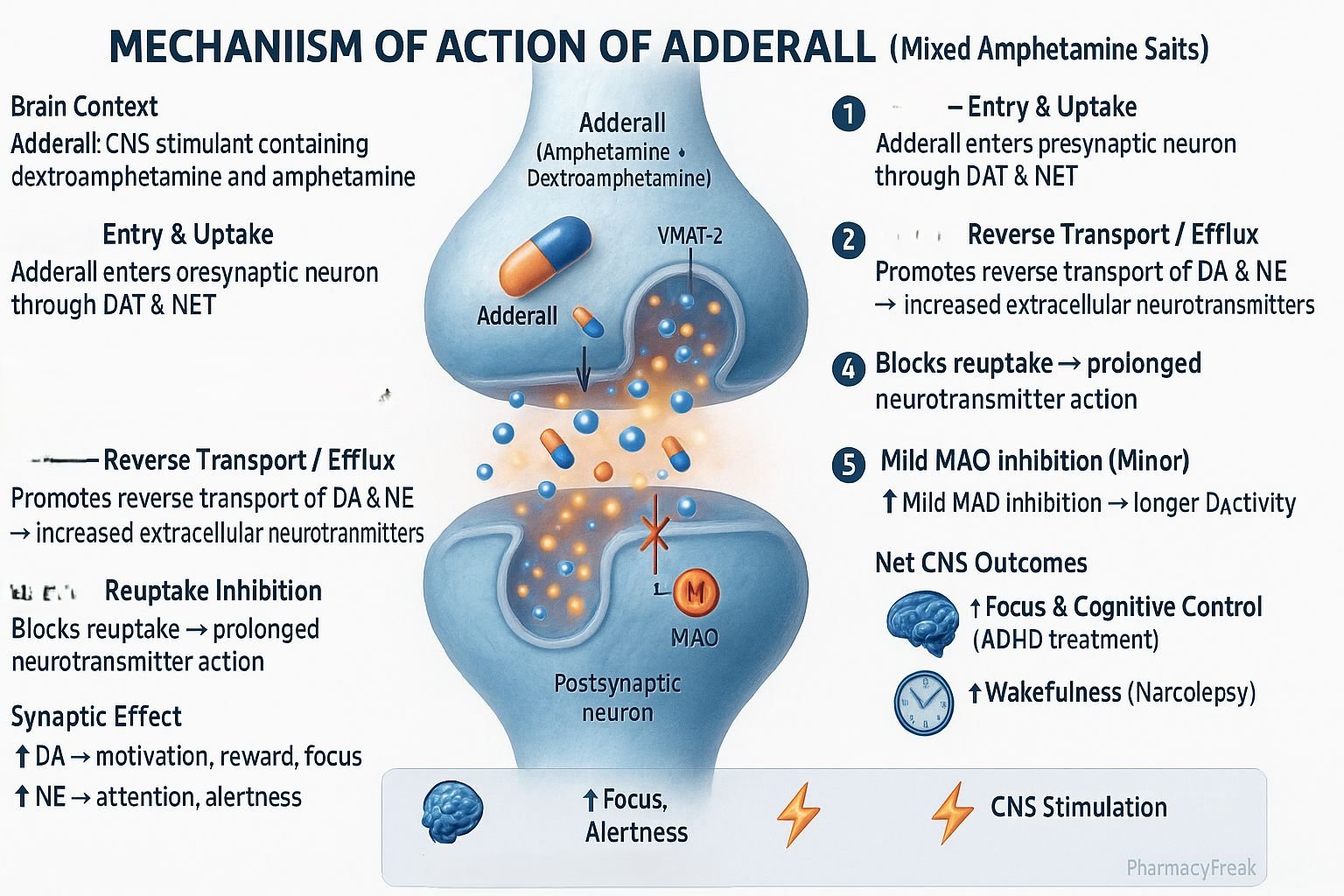Table of Contents
Introduction
Adderall is a central nervous system (CNS) stimulant containing a combination of amphetamine and dextroamphetamine. Mechanism of Action of Adderall involves increasing the levels of key neurotransmitters—dopamine, norepinephrine, and serotonin—in the brain. It is primarily prescribed for Attention-Deficit/Hyperactivity Disorder (ADHD) and narcolepsy, improving focus, alertness, and cognitive performance. Understanding its pharmacological mechanism helps explain its therapeutic benefits and potential for misuse or dependence.

Mechanism of Action (Step-wise)
- Stimulation of Catecholamine Release
- Adderall enters presynaptic neurons via diffusion and uptake through the dopamine transporter (DAT) and norepinephrine transporter (NET).
- Inside the neuron, it displaces dopamine and norepinephrine from synaptic vesicles by interacting with the vesicular monoamine transporter-2 (VMAT-2).
- Increased Synaptic Concentrations
- The displaced dopamine and norepinephrine are released into the synaptic cleft by reverse transport through DAT and NET.
- This leads to elevated extracellular levels of these neurotransmitters in key brain regions (prefrontal cortex, striatum, and nucleus accumbens).
- Inhibition of Reuptake
- Adderall inhibits reuptake of dopamine and norepinephrine, prolonging their synaptic action.
- Mild Monoamine Oxidase (MAO) Inhibition
- It mildly inhibits MAO, reducing neurotransmitter breakdown and further increasing monoamine availability.
- CNS Activation
- Enhanced dopaminergic and noradrenergic signaling leads to increased attention span, alertness, and control of impulsive behavior.
- Overall Effect
- Therapeutic: Improves focus, attention, and wakefulness in ADHD and narcolepsy.
- Adverse (at high doses): Euphoria, restlessness, insomnia, and risk of dependence due to excessive dopaminergic stimulation.

Pharmacokinetics
- Absorption: Rapidly absorbed after oral administration.
- Distribution: Widely distributed; crosses the blood-brain barrier easily.
- Metabolism: Partially metabolized in the liver by CYP2D6.
- Excretion: Primarily renal, with pH-dependent elimination (acidic urine increases excretion).
- Half-life: 9–14 hours (longer in alkaline urine).
Clinical Uses
- Attention-Deficit/Hyperactivity Disorder (ADHD).
- Narcolepsy (to reduce daytime sleepiness).
- Off-label: treatment-resistant depression and cognitive enhancement (under strict supervision).
Adverse Effects
- Common: Insomnia, dry mouth, loss of appetite, anxiety, tachycardia.
- Less common: Hypertension, irritability, headache, gastrointestinal upset.
- Serious: Cardiovascular events, psychosis, seizures, dependence and abuse potential.
- Contraindications: History of cardiovascular disease, hyperthyroidism, glaucoma, severe anxiety, or substance use disorder.
Comparative Analysis
| Feature | Adderall | Methylphenidate (Ritalin) | Modafinil |
|---|---|---|---|
| Mechanism | ↑ Dopamine, norepinephrine release & reuptake inhibition | DAT/NET reuptake inhibition | ↑ Histamine, dopamine, orexin activity |
| Onset of action | 30–60 minutes | 30–45 minutes | 1–2 hours |
| Duration (XR forms) | 10–12 hours | 6–8 hours | 12–15 hours |
| Abuse potential | High | Moderate | Low |
| Primary use | ADHD, narcolepsy | ADHD | Narcolepsy, fatigue |
MCQs
1. What is the primary mechanism of action of Adderall?
a) GABA receptor activation
b) Dopamine and norepinephrine release and reuptake inhibition
c) Serotonin receptor blockade
d) Glutamate receptor antagonism
Answer: b) Dopamine and norepinephrine release and reuptake inhibition
2. Which transporter is primarily involved in Adderall’s mechanism?
a) VMAT-1
b) DAT and NET
c) SERT
d) GAT-1
Answer: b) DAT and NET
3. Adderall enhances neurotransmitter levels by:
a) Blocking their synthesis
b) Increasing vesicular uptake
c) Promoting reverse transport into the synapse
d) Enhancing degradation
Answer: c) Promoting reverse transport into the synapse
4. Which enzyme is mildly inhibited by Adderall?
a) COMT
b) MAO
c) Acetylcholinesterase
d) Tyrosine hydroxylase
Answer: b) MAO
5. The half-life of Adderall depends on:
a) Urinary pH
b) Plasma protein levels
c) Age of the patient
d) Food intake
Answer: a) Urinary pH
6. Adderall is contraindicated in patients with:
a) Diabetes
b) Cardiovascular disease
c) Migraine
d) Anemia
Answer: b) Cardiovascular disease
7. Which neurotransmitters are most affected by Adderall?
a) GABA and glutamate
b) Dopamine and norepinephrine
c) Acetylcholine and serotonin
d) Histamine and orexin
Answer: b) Dopamine and norepinephrine
8. Which drug class does Adderall belong to?
a) Benzodiazepine
b) Stimulant
c) Antidepressant
d) Anticonvulsant
Answer: b) Stimulant
9. Which enzyme primarily metabolizes Adderall?
a) CYP3A4
b) CYP2D6
c) CYP2C9
d) CYP1A2
Answer: b) CYP2D6
10. Which adverse effect is associated with chronic Adderall use?
a) Hypotension
b) Dependence and tolerance
c) Hypoglycemia
d) Hyperthermia only
Answer: b) Dependence and tolerance
FAQs
Q1. Does Adderall increase dopamine levels?
Yes, it promotes dopamine release and inhibits its reuptake, enhancing CNS activity.
Q2. How long does Adderall last?
Immediate-release lasts 4–6 hours, while extended-release (XR) lasts 10–12 hours.
Q3. Is Adderall addictive?
Yes, prolonged or unsupervised use can lead to tolerance, dependence, and addiction.
Q4. Can Adderall cause cardiovascular problems?
Yes, it can raise heart rate and blood pressure; caution is advised in cardiac patients.
Q5. Is Adderall used for depression?
Sometimes used off-label for treatment-resistant depression under specialist supervision.
Q6. What is the difference between Adderall and Ritalin?
Adderall enhances neurotransmitter release, while Ritalin mainly blocks their reuptake.
References
- Goodman & Gilman’s The Pharmacological Basis of Therapeutics
- Katzung’s Basic and Clinical Pharmacology
- Stahl’s Essential Psychopharmacology
- FDA Prescribing Information on Adderall
Related Internal Links

I am pursuing MBA in pharmaceutical management from NIPER Hyderabad with a strong academic record and proven success in national-level pharmacy entrance exams. I secured AIR 61 in NIPER 2024 (MS/M.Pharm) and AIR 27 in NIPER MBA, along with AIR 147 in GPAT 2024 and AIR 907 in GPAT 2023. I also achieved AIR 6 in AIIMS CRE-2025 for Drug Store Keeper and was selected as a Pharmacist (AIR 61) for ESIC. Additionally, I was the Runner-Up in Round 2 of the EY Case Study Competition.
At PharmacyFreak.com, I aim to guide future pharmacists through expert content, exam strategies, and insightful resources based on real experience and academic excellence.
Mail- harsh@pharmacyfreak.com
